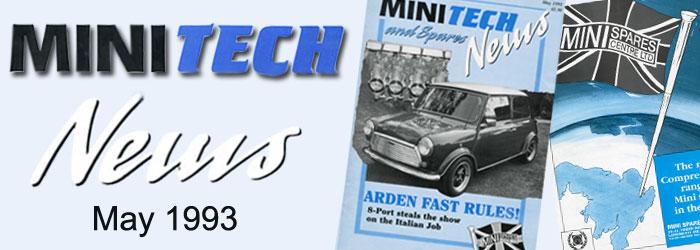WHAT'S THE "DIFF"ERENCE?
 Following my first attempt to explain in 'English' what a limited slip differential (LSD) does, I have been inundated with callers as to which type is the best to use. There are several types on the market of differing designs, and are commonly referred to by their respective manufacturers . name rather than their design type. For instance, many people still talk about an LSD for a Mini as being a 'Salisbury' simply because this was one of the earliest readily available and widely used types. The fact that it is basically a plate type diff is never mentioned.
Following my first attempt to explain in 'English' what a limited slip differential (LSD) does, I have been inundated with callers as to which type is the best to use. There are several types on the market of differing designs, and are commonly referred to by their respective manufacturers . name rather than their design type. For instance, many people still talk about an LSD for a Mini as being a 'Salisbury' simply because this was one of the earliest readily available and widely used types. The fact that it is basically a plate type diff is never mentioned.
Rather than go into deep technical detail and description of each design, it is necessary to understand what makes the most effective diff, then go on to the comparative effectiveness - or ineffectiveness - of each design type. This understanding of what makes a diff work to give optimum efficiency is of primary importance as the monetary investment is quite high. The understanding will enable the right choice to be made to maximise the investment.
The best diff is one that transfers most torque to the road wheels in adverse driving conditions, ie. when one wheel is on dry tarmac, the other on black wet ice. If this can be altered to suit the relevant application for eitherdriver or track type, so much the better.
So which diff type is most effective? Easy, the plate type. It has the largest area of friction, and the latest design has variable ramp rates to allow changes to the percentage of torque transfer in both acceleration or deceleration, and variable preload to allow changes to the point at which the diff starts to work. This latest type of design is only similar to the old Salisbury type in as much as it uses plates - otherwise it is far more refined, and superior in manufacture quality.
The other types? Well, due to their deSign they are not particularly efficient or effective - but have their ardent supporters none the less. Examination of their internals and how they function clearly shows their shortcomings in comparison to a plate type diff. They have far less useable, and therefore operational, frictional area and are not variable in any way. The pawl type is either on or off - similar to a locker diff. Once engaged it works like a welded diff, the only Slip experienced is of a ratcheting nature caused by the diff locking and unlocking on uneven surfaces giving different amounts of grip on either wheel. This in turn causes severe snatching of the steering wheel. Horrendous wear rates are a result of the action of the diff, and frequent and somewhat expensive rebuilds are necessary to maintain maximum performance.
The gear type has probably the least amount of operational friction area, only working when both road wheels have grip - defeating the point of fitting an LSD in the first place. Wear rates are not very high due to it's ineffectiveness - but when worn a whole newdiff unit is often required. The lack of operational effect can easily be tested with this type on a normal unlocked brake tester. With load on one wheel the other will spin freely like a normal diff, whereas a functioning LSD would pull out of the rollers. It is often referred to as 'user friendly' another way of saying ineffective.
At the end of the day the acid test was a direct comparison that we undertook on a rally-cross front wheel drive car at Lydden Hill. The plate type improved race times by 7 seconds over a 3 lap heat - the car instantly becoming a front runner. The vast majority of factory teams do not run gear or pawl type diffs. Hopefully this makes things black and white. Needless to say, Mini Spares sell plate type diffs.
Importation rules regarding vehicles are very specific: Only those over 25 years in age may be brought in to the USA without compilance to Federal Motor Vehicle Safety Standards (FMVSS).Author
admin

